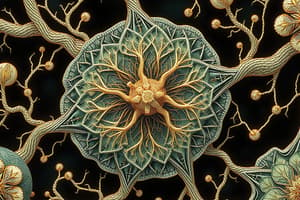Podcast
Questions and Answers
What is the primary function of nervous tissue?
What is the primary function of nervous tissue?
- Aiding in digestion
- Conducting nerve impulses throughout the body (correct)
- Producing hormones
- Regulating body temperature
Which function of tissues involves muscles contracting to produce motion?
Which function of tissues involves muscles contracting to produce motion?
- Movement (correct)
- Protection
- Support & structural integrity
- Integrated communication & response
Apart from providing structure and strength, what other roles do connective tissues play?
Apart from providing structure and strength, what other roles do connective tissues play?
- Regulate heart rate
- Produce energy for the body
- Regulate blood sugar levels
- Facilitate immune responses (correct)
What is a crucial function of epithelial tissues?
What is a crucial function of epithelial tissues?
What allows for coordinated activity among all organ systems in the body?
What allows for coordinated activity among all organ systems in the body?
What is the main function of epithelial tissue?
What is the main function of epithelial tissue?
Where can smooth muscles mainly be found?
Where can smooth muscles mainly be found?
Which type of tissue is responsible for maintaining homeostasis by transporting nutrients and waste products?
Which type of tissue is responsible for maintaining homeostasis by transporting nutrients and waste products?
Which type of tissue is tightly packed with no gaps between cells forming protective barriers?
Which type of tissue is tightly packed with no gaps between cells forming protective barriers?
What is the role of skeletal muscles?
What is the role of skeletal muscles?
Flashcards are hidden until you start studying
Study Notes
Tissues: A Foundation of Life's Complexity
Tissues are fundamental building blocks of living organisms, formed by groups of specialized cells organized together to perform specific tasks. In multicellular structures like our own bodies, these cellular communities work harmoniously to carry out various essential functions. Let's delve deeper into understanding different kinds of tissues and their roles within this intricate biological network.
Types of Tissues
Organisms possess diverse types of tissues that contribute to unique characteristics and adaptations. Four main categories exist:
-
Epithelial tissue: Cells tightly packed with no gaps between them forming protective barriers and involved in absorption, secretion, filtration, and exchange of materials across interfaces. Examples include skin and the lining of blood vessels.
-
Connective tissue: Provides support, protection, and movement, while also maintaining homeostasis through its role in transporting nutrients and waste products around the body. Examples range from dense collagen fibers in tendons to loose fatty deposits in adipose tissue.
-
Muscle tissue: Contractile units responsible for physical movements and generating heat. There are three main muscle types: skeletal muscles attached to bones facilitating voluntary actions; smooth muscles present in internal organs enabling involuntary motions; cardiac muscles found exclusively in heart walls ensuring rhythmic contractions.
-
Nervous tissue: Conducts nerve impulses throughout the body, transmitting signals from sensory receptors to the central nervous system and back again. Neurons, or nerve cells, form complex networks that coordinate numerous bodily processes.
Functions of Tissues
The primary purposes of tissues can be categorized into four key areas:
-
Protection: Protective barriers made up of epithelial cells safeguard vital structures such as the epidermis covering skin, mucosae in respiratory tracts, and ovarian follicles inside the ovary.
-
Support & structural integrity: Skeletal systems composed of bone tissue maintain posture and proper positioning, while connective tissues hold other organs and tissues in place and function outside of the skeleton.
-
Movement: Muscles contract to produce motion allowing us to move physically, breathe, pump blood, and control facial expressions.
-
Integrated communication & response: Nerves transmit electrical signals via neurons to convey information throughout the body. This allows for coordinated activity among all organ systems.
Let's focus on one particularly important type of tissue – connective tissue.
Connective tissues play critical roles beyond providing structure and strength. They act as reservoirs storing minerals and water necessary for metabolism, facilitate immune responses, and regulate blood clotting following injury. Furthermore, they contain various growth factors influencing cell behavior during development and repair.
Epithelial tissues are also crucial due to their barrier properties protecting against pathogens and dehydration. Additionally, they manage selective passage of molecules, forming the basis of numerous physiological processes occurring at interfacial surfaces.
Remember, the complexity and versatility of life stem from the unique interactions among multiple layers of organization, including tissues!
Studying That Suits You
Use AI to generate personalized quizzes and flashcards to suit your learning preferences.



